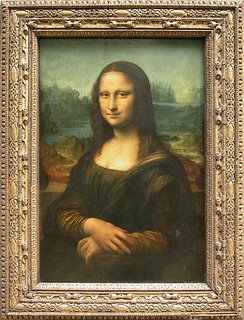 It has been a long held belief that Leonardo Davinci's "Mona Lisa" 1503-1506 is one big mystery; this isn't exactly true. It's known, according to the account of Georgio Vasari, that its a portrait of Lisa Gioconda the wife of a Florentine silk merchant. The real mysteries are mostly the result of a filthy painting that's too popular to remove from display and clean. Most people who visit the Louvre go specifically to see the "Mona Lisa", but is it really important to appease the people or should preservationists clean the portrait?
It has been a long held belief that Leonardo Davinci's "Mona Lisa" 1503-1506 is one big mystery; this isn't exactly true. It's known, according to the account of Georgio Vasari, that its a portrait of Lisa Gioconda the wife of a Florentine silk merchant. The real mysteries are mostly the result of a filthy painting that's too popular to remove from display and clean. Most people who visit the Louvre go specifically to see the "Mona Lisa", but is it really important to appease the people or should preservationists clean the portrait?Once a year the painting is removed from the protective case in order to check the panel for warping and to change the silica preservative inside the glass box. During this time a special investigative team has used a special laser see through the dirt and investigate the painting through the centuries of grime. After these laser assisted studies, historians have been able to reveal evidence that the "Mona Lisa" was probably a recent mother; as indicated by a thin veil traditionally worn by nursing women at the time. A copy of the "Mona Lisa", dated to the early 17th century, reveals many of the details that have been hidden in the original painting. The painting is certainly more striking when the details are all fully visible.
 Yes, it would be annoying to visit the Louvre to see the "Mona Lisa" and find that it had been removed for cleaning, but the interpretation of a clean image could be monumental. Besides, the Louvre contains one of the largest and most spectacular collections of art in the world; anyone who goes to see only the "Mona Lisa" is missing out on the vast collection which includes "The Venus de Milo", Leonardo's "Virgin and Child with St. Anne", Vermeer's "Lacemaker", David's "Oath of the Horatii", and Gericault's "Raft of Medusa" just to name a few. It might be good for some people to be forced into looking at something they might never have seen had the "Mona Lisa" been there to distract them.
Yes, it would be annoying to visit the Louvre to see the "Mona Lisa" and find that it had been removed for cleaning, but the interpretation of a clean image could be monumental. Besides, the Louvre contains one of the largest and most spectacular collections of art in the world; anyone who goes to see only the "Mona Lisa" is missing out on the vast collection which includes "The Venus de Milo", Leonardo's "Virgin and Child with St. Anne", Vermeer's "Lacemaker", David's "Oath of the Horatii", and Gericault's "Raft of Medusa" just to name a few. It might be good for some people to be forced into looking at something they might never have seen had the "Mona Lisa" been there to distract them.